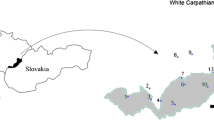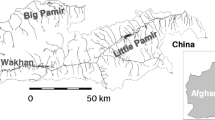Abstract
The decades following 1492 launched an era of European overseas expansion, which led to an unprecedented intercontinental exchange of plant and animal species. Literature on the Columbian Exchange emphasizes the New World and Asian crops that revolutionized the food systems of Africa but ignores the role of African crops in the New World tropics. This chapter draws attention to the neglected African components of the Columbian Exchange. The movement of African plant and food animals across the Atlantic Ocean in the initial period of plantation development depended on the transatlantic slave trade for their dispersal. Plants and animals arrived on slave ships together with African captives for whom the species were traditional dietary staples, medicinals, and food animals. A proper appreciation of African contributions to New World agricultural systems requires a new perspective on plantation societies, one that shifts standard research from the export commodities that slaves grew to the plants they cultivated for their own needs. This in turn draws attention to the significance of African species as a vital logistical support of the transatlantic slave trade and to the agency of enslaved Africans in pioneering cultivation of familiar dietary plants in their dooryard gardens and food fields.
Access this chapter
Tax calculation will be finalised at checkout
Purchases are for personal use only
Similar content being viewed by others
Notes
- 1.
Nearly 40% of the slaves traded to the Americas went to Brazil, which exceeded more than three million Africans between the sixteenth and nineteenth centuries. Brazil was the last country in the Western Hemisphere to abolish slavery, which was decreed in 1888.
- 2.
A plant of South American origin, the peanut had not made it as far as mainland North America and parts of the Caribbean in pre-Columbian times. Established in Africa in the early sixteenth century, the peanut arrived in English plantation colonies as leftover provisions on slave ships. Slaveholders in these areas adopted the African names for a foodstaple with which slaves were quite familiar.
References
Alpern SB (2008) Exotic plants of Western Africa: where they came from and when. Hist Afr 35:63–102
Barbot J (1752) A description of the coasts of North and South Guinea; and of Ethiopia inferior, vulgarly Angola; being a new and accurate account of the Western Maritime Countries of Africa. In: Churchill A (ed) A collection of voyages and travels, some now first printed from original manuscripts, others now first published in English, 8 vols, vol V. Printed from Messieurs Churchill for T. Osborne, London, p 99
Buvelot Q (2004) Albert Eckhout: a Dutch artist in Brazil. Waanders Publishers, The Hague
Carney J (2001) Black rice: the African origins of rice cultivation in the Americas. Harvard University Press, Cambridge, MA
Carney J (2004) ‘With grains in her hair’: rice history and memory in colonial Brazil. Slavery Abolit 25(1):1–27
Carney J (2005) Rice and memory in the age of enslavement: Atlantic passages to Suriname. Slavery Abolit 26(3):325–347
Carney J, Acevedo R (2004) Saberes agrícolas dos escravos africanos no Novo Mundo. Ciência hoje 35(205):26–33
Carney J, Acevedo Marin R (1999) Aportes dos escravos na história do cultivo do arroz africano nas Américas. Estudos sociedade e agricultura 12:113–133
Carney J, Rosomoff R (2009) In the shadow of slavery: Africa’s botanical legacy in the Atlantic World. University of California Press, Berkeley
Cassidy FG, Le Page RB (2002) Dictionary of Jamaican English. University of the West Indies Press, Kingston
Chase A (1944) Grasses of Brazil and Venezuela. Agric Am 4:123–126
Corrêa do Lago P (2001) Iconografia Brasileira. Itáu Cultural, São Paulo
Crosby AW (1972) The Columbian exchange: biological and cultural consequences of 1492. Greenwood Press, Westport
Crosby AW (1986) Ecological imperialism: the biological expansion of Europe, 900–1900. Cambridge University Press, New York
Cymbron T, Loftus RT, Malheiro MI, Bradley DG (1999) Mitochondrial sequence variation suggests an African influence in Portuguese cattle. Proc R Soc Lond B 266:597–603
de Langhe E (1995) Banana and plantain: the earliest fruit crops? Annual report, INIBAP, Montpellier
Debret JB (1954) Viagem pitoresca e histórica ao Brasil: 1834–1839, 2 vols. Livraria Martins, São Paulo
Donkin RA (1991) Meleagrides: an historical and ethnogeographical study of the guinea fowl. Ethnographica, London
Eltis D, Behrendt S, Richardson D, Klein H (1999) The trans-Atlantic slave trade: a database on CD-ROM. Cambridge University Press, Cambridge
Gamble DP, Hair PEH (eds) (1999) The discovery of River Gambra (1623) by Richard Jobson. Hakluyt, London
Ginja C, Penedo MCT, Melucci L, Quiroz J, Marínez López OR, Revidatti MA, Martínez-Martínez A, Delgado JV, Gama LT (2009) Origins and genetic diversity of New World Creole cattle: inferences from mitochondrial and Y chromosome polymorphisms. Anim Genet 41:128–141
Grimé W (1979) Ethno-botany of the Black Americans. Reference Publications, Algonac
Hair PEH, Jones A, Law R (1992) Barbot on Guinea: the writings of Jean Barbot on West Africa, 1678–1712, 2 vols. Hakluyt, London
Harlan JR (1975) Crops and man. Crop Society of America, Madison
Hazard S (1971) Cuba with pen and pencil. Hartford Publishing Co., Hartford
Kimber CT (1988) Martinique revisited: the changing plant geographies of a West Indian island. Texas A & M University Press, College Station
Kleiman K (2003) The pygmies were our compass: Bantu and Batwa in the history of West Central Africa, early times to c. 1900 C.E. Heinemann, Portsmouth
Kupperman KO (1993) Providence Island, 1630–1641: the other Puritan colony. Cambridge University Press, New York
Ligon R (1970 [1647]) A true & exact history of the island of Barbadoes. Frank Cass & Co., London
Lirón JP, Bravi CM, Mirol PM, Peral-García P, Giovambattista G (2006) African matrilineages in American Creole cattle: evidence of two independent continental sources. Anim Genet 37:379–382
MacNeish R (1992) The origins of agriculture and settled life. University of Oklahoma Press, Norman
Magee DA, Meghen C, Harrison S, Troy CS, Cymbron T, Gaillard C, Morrow A, Maillard JC, Bradley DG (2002) A partial ancestry for the creole cattle populations of the Caribbean. J Hered 93:429–432
Marcgrave J (Georg) (1942 [1648]) História natural do Brasil. Imprensa Oficial do Estado, São Paulo
Mbida CM, Van Neer W, Doutrelepont H, Vrydaghs L (2000) Evidence for banana cultivation and animal husbandry during the first millennium BC in the forest of southern Cameroon. J Archaeol Sci 27:151–162
McClellan JE III (1992) Colonialism and science: Saint Domingue in the old regime. The Johns Hopkins Press, Baltimore
McNeill JR (2000) Biological exchange and biological invasion in world history. Paper presented at the 19th international congress of the historical sciences, Oslo, 6–13 August
Mercer J (1973) Canary Islands: Fuerteventura. Stackpole Books, Harrisburg
National Research Council (NRC) (1996) Lost crops of Africa, vol 1, Grains. National Academy Press, Washington, DC
National Research Council (NRC) (2006) Lost crops of Africa, vol 2, Vegetables. National Academy Press, Washington, DC
Parsons JJ (1970) The “Africanization” of the New World tropical grasslands. Tübinger Geographische Studien 34:141–153
Pessoa de Barros JF (1993) A galinha d’angola: Iniciação e identidade na cultura Afro-Brasileira. Universidade Federal Fluminense, Rio de Janeiro
Pessoa de Barros JF, Napoleão E (1998) Ewé Òrìsà: Uso litúrgico e terapêutico dos vegetais nas casas de candomblé Jêje-Nago. Betrand Brasil, Rio de Janeiro
Pike R (1967) Sevillian society in the sixteenth century: slaves and freedmen. Hisp Am Hist Rev 43(3):344–359
Piso G (Willem) (1957 [1648]) História natural e médica da India Ocidental. Instituto Nacional do Livro, Rio de Janeiro
Restall M (2000) Black conquistadors: armed Africans in early Spanish America. Americas 57(2):171–205
Rugendas JM (1954) Viagem pitoresca através do Brasil. Livraria Martine Editôra, São Paulo
Rumeu de Armas A (1956) España en el Africa Atlántica. Consejo Superior de Investigaciónes Científicas, Madrid
Saunders ACdeCM (1982) A social history of black slaves and freedmen in Portugal, 1441–1555. Cambridge University Press, Cambridge
Schneider JT (1991) Dictionary of African borrowings in Brazilian Portuguese. Helmut Buske Verlog, Hamburg
Slenes R (2002) African Abrahams, Lucretias and men of sorrows: allegory and allusion in the Brazilian anti-slavery lithographs (1827–1835) of Johan Moritz Rugendas. Slavery Abolit 23(2):147–169
Sloane H (2001) Page 254, vol I. Quoted in Edwards B (2001) [1793] History, civil and commercial, of the British colonies in the West Indies, 5 vols. Adamant Media, Chestnut Hill
Voeks R (1997) Sacred leaves of candomblé. University of Texas Press, Austin
Watts D (1987) The West Indies: patterns of development, culture, and environmental change since 1492. Cambridge University Press, Cambridge
Watts D (2000) Early Hispanic new world agriculture, 1492 to 1509. In: Shepherd V, Beckles HMcD (eds) Caribbean slavery in the Atlantic World: a student reader. Marcus Wiener, Princeton, pp 136–152
Wilson MT (1964) Peaceful integration: the owner’s adoption of his slaves’ food. J Negro Hist 49(2):116–127
Acknowledgments
Earlier versions of this chapter were presented at the Michigan State University (2005), the University of Wisconsin (2006), the annual meetings of the Brazilian Studies Association (2008), and the Society for Economic Botany in May 2009. I wish to thank these audiences for raising provocative questions that guided this chapter’s evolution. I am grateful to Antoinette WinklerPrins for bringing my attention to Fig. 2.5, her father, who kindly sent the Eckhout exhibition book from the Netherlands, and to Chase Langford, the UCLA Geography Department cartographer, for scanning and enhancing that image. I wish to thank Michael O’Grady for assistance with fieldwork in Pará (1996); Rosa Acevedo, my collaborator on quilombo fieldwork in Maranhão and Pará (1996, 1997, 2002); Leonard Abrams, Seu Benedito, Dona Maria, and Ivã with research on quilombos near Itapecurú, Maranhão in 2002. Additional gratitude is extended to Jacque Chase, my collaborator in the Minas Gerais quilombo research in 2005.
Author information
Authors and Affiliations
Corresponding author
Editor information
Editors and Affiliations
Rights and permissions
Copyright information
© 2013 Springer Science+Business Media New York
About this chapter
Cite this chapter
Carney, J. (2013). Seeds of Memory: Botanical Legacies of the African Diaspora. In: Voeks, R., Rashford, J. (eds) African Ethnobotany in the Americas. Springer, New York, NY. https://doi.org/10.1007/978-1-4614-0836-9_2
Download citation
DOI: https://doi.org/10.1007/978-1-4614-0836-9_2
Published:
Publisher Name: Springer, New York, NY
Print ISBN: 978-1-4614-0835-2
Online ISBN: 978-1-4614-0836-9
eBook Packages: Biomedical and Life SciencesBiomedical and Life Sciences (R0)




